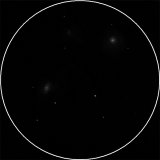
| MESSIER 60 |
|---|
RA: |
12h 43m 42s |
|
DEC: |
+11° 33' 00'' |
|
Type: |
Elliptical galaxy |
|
NGC: |
4649 |
|
Magnitude: |
8.80 |
|
Surface brightness : |
12.90 |
|
Apparent dimensions : |
7.6'x6.2' |
|
Distance: |
60,000,000 ly |
|
Discovered 1779 by Johann Gottfried Koehler. M60 is one of the giant elliptical galaxies in the Virgo Cluster of galaxies. As the most following (eastern) Messier galaxy in this cluster, it is the last in a row of three (M58, M59, and M60), which comes into the field of view of a telescope pointed to this region of the sky. At lower magnifications, it lies in the same field of view as M59 (25 arc minutes away). M60 was discovered by Johann Gottfried Koehler on April 11, 1779, when he was following the comet of that year, together with neighboring M59. It was independently found one day later by Barnabus Oriani, who missed M59, and four days later, on April 15, 1779, by Charles Messier, who also found nearby M58. Messier describes M60 as "a little more distinct" than M58 and M59. At its distance of some 60 million light years, this galaxy's apparent diameter of 7x6 arc minutes corresponds to a linear diameter of 120,000 light years. Amateur telescopes, however, do only show its bright central region of about 4x3 arc minutes diameter. Its visually 9th apparent magnitude makes it a very bright galaxy of absolute magnitude -22.3, corresponding to an intrinsic luminosity of 60 billion suns. M60 is conspicuous in telescopes starting from 4 inch because of its faint neighbor, NGC 4647. |
||
OTHER SKETCHES |
|||||
 |
|||||
M58,M60, NGC 4638, NGC4647 (2008.) |
|||||
VEDRAN VRHOVAC© 2006.-2007. |
